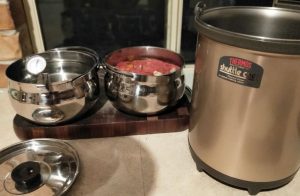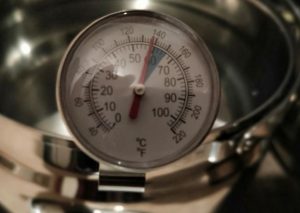The three major components of operating an energy efficient home include the design of the house, the energy efficiency of the home’s appliances and the habits of the inhabitants.
I want to focus on appliances but specifically those energy efficient appliances that are outside of the system and are therefore not sporting a rating indicating the projected yearly consumption of energy in kWh/annum, or showing a flashy star rating indicating the appliance’s energy efficiency whilst operating under ideal conditions.
 Many clever gadgets operate outside of this “star system” and are so versatile that they cannot be accurately rated.
Many clever gadgets operate outside of this “star system” and are so versatile that they cannot be accurately rated.
Tricks and hacks are used in every facet of life including home energy efficiency. In competitive industries, tricks of the trade are rarely shared and hidden and protected as trade secrets.
It is, however, not uncommon for a clever mind to adapt a tool or practice specifically designed for one function in one field and used/modified/adapted to perform a completely different function in another.
Harmonicas, being a wind instrument, were originally designed to sound by having exhaled air , that is, the breath of the musician vibrate over a thin strip of brass, known as a reed causing it to vibrate and produce a sound. Because harmonicas are relatively inexpensive musical instruments, they were affordable and therefore became quite popular within the poorer communities and especially those of the African American community in the United States. Doing exactly the opposite from how they were designed to functions, that is, using inhaled air passing over the reeds, being the opposite direction, a completely different sound is produced and the blues harp sound become an integral part of that specific musical genre. Some innovative individual invents a tool for a certain function and yet another innovative individual uses it to function in an entirely different way than its original purpose.
Our home has a gas stove. The two main reasons why we elected to go with gas for cooking was because using gas is a more efficient way to cook and secondly because when we set up our home we had a standalone electricity system and a kilowatt hour of electricity was initially calculated to have cost us between 60 and 70 cents at a time when grid supplied electricity was only 14 cents per kilowatt-hour.
Whilst we do have an electric slow cooker, leaving it on through the day when no one is home is not that wise even though it can be programmed and will most likely operate safely, there is a chance that something could go wrong, ie. a disruption in the electricity supply which would affect the set temperature and time for cooking.
We also have a gas pressure cooker, which is very efficient, however no one in their right mind would go to work leaving the gas on unsupervised.
Another slow cooking option, that would be rarely seen in a kitchen because it was designed for camping and traveling, is a unit that has two x 3 litre pots (see pic 1) that, once heated on a gas or electric stove can be placed inside a thermally sealed flask that contains and preserves the heat which is used to continue the cooking. The sealed unit minimises heat loss that naturally occurs on a stove top. The second law of thermodynamics, that is, the law of entropy, dictates that heat energy is evenly dispersed overtime, that is, a hot saucepan will dissipate heat into the cooler atmosphere. That’s heat energy lost and consequently energy-efficiency lost. With these camping units the energy is contained within a sealed unit and therefore that same heat energy can continue to cook food until it is ultimately dissipated and lost into a cooler environment.
There are a number of units on the market that do similar things and I’m not recommending any particular brand but eventually whatever is put inside these containers will cool down because they are not perfectly sealed. That being the case however, the units can successfully contain heat energy and continue to cook food within the saucepans hour after hour without any further energy input. To be able to use the already generated heat energy for the whole day makes these units extremely energy efficient. Once these units have been set up in the morning, anyone to go to work for the whole day knowing that there’s no chance of any safety issue through the day. Safety AND energy efficiency, … it’s a win-win situation.
 The meal that was cooked in our unit on this day that the photos were taken had one 3 litre saucepan filled with vegetables and a few lamb chops which were left on the gas stove for about 10 minutes and then placed in the sealed container with the other 3 litre saucepan placed on top with boiling water. The heat does rise, that is true, but within the sealed container eventually everything will be the same temperature.
The meal that was cooked in our unit on this day that the photos were taken had one 3 litre saucepan filled with vegetables and a few lamb chops which were left on the gas stove for about 10 minutes and then placed in the sealed container with the other 3 litre saucepan placed on top with boiling water. The heat does rise, that is true, but within the sealed container eventually everything will be the same temperature.
On this occasion, cooking took place for 11 hours and when we opened it up I was a bit slow to take the photo but the temperature was about 65 degrees which is at the top end of the “food safe” temperature. It still showed 60 degrees, see pic 2, after it had been opened and we placed the thermometer in the water to get a reading. A perfect evening meal, ready to go when you are, and big enough for the parents of an empty-nester household. Thinking outside the box for convenience and energy efficiency is not an Olympic sport but there must be a plethora of workable ideas that have not yet been discovered or applied.
Get your FREE copy of “Savvy Up and Save” here >>>LEARN MORE>>>
Moreton Bay residents can access weekly tips from John on Community Radio 101.5 FM Friday Mornings at 10:10am
John Lynn
